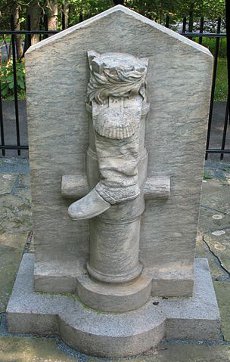
In October 1780, a month after Benedict Arnold defected to the British, this acrostic appeared in American newspapers:
B orn for a curse to virtue and mankind,
E arth’s broadest realm ne’er knew so black a mind.
N ight’s sable veil your crimes can never hide,
E ach one so great, ‘twould glut historic tide.
D efunct, your cursed memory will live
I n all the glare that infamy can give.
C urses of ages will attend your name,
T raitors alone will glory in your shame.
A lmighty vengeance sternly waits to roll
R ivers of sulphur on your treacherous soul:
N ature looks shuddering back with conscious dread
O n such a tarnished blot as she has made.
L et hell receive you, riveted in chains,
D oomed to the hottest focus of its flames.
Arnold’s perfidy so blackened his name that he’s strangely absent even from his own memorials. A monument (above) at the site of the Battle of Saratoga depicts only a boot, to reflect the leg wound that ended Arnold’s fighting career. His name appears nowhere in the inscription:
In memory of
the “most brilliant soldier” of the
Continental Army
who was desperately wounded
on this spot the sally port of
BORGOYNES GREAT WESTERN REDOUBT
7th October, 1777
winning for his countrymen
the decisive battle of the
American Revolution
and for himself the rank of
Major General.
A second monument at Saratoga includes four niches: Three contain statues of Horatio Gates, Philip Schuyler, and Daniel Morgan, but the fourth niche is empty.
And West Point displays a commemorative plaque for every general who served in the revolution. One plaque bears a rank and a date (“Major General / Born 1740”), but no name.
